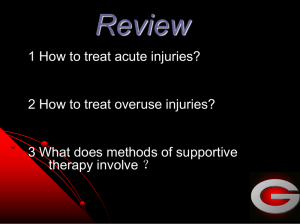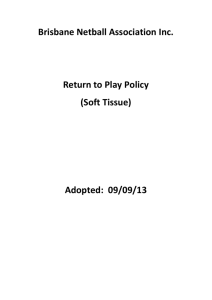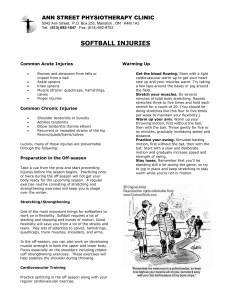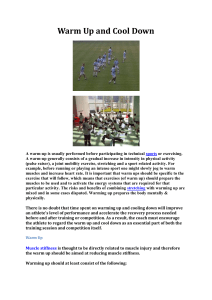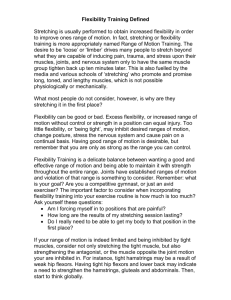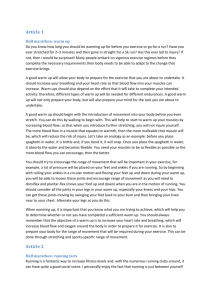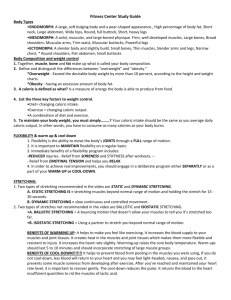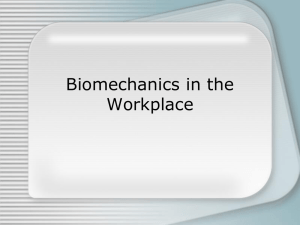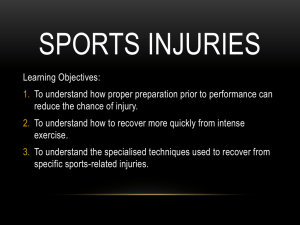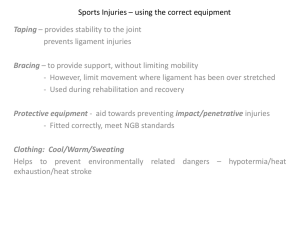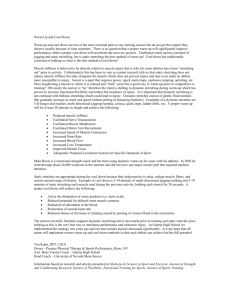Injuryprevention
advertisement
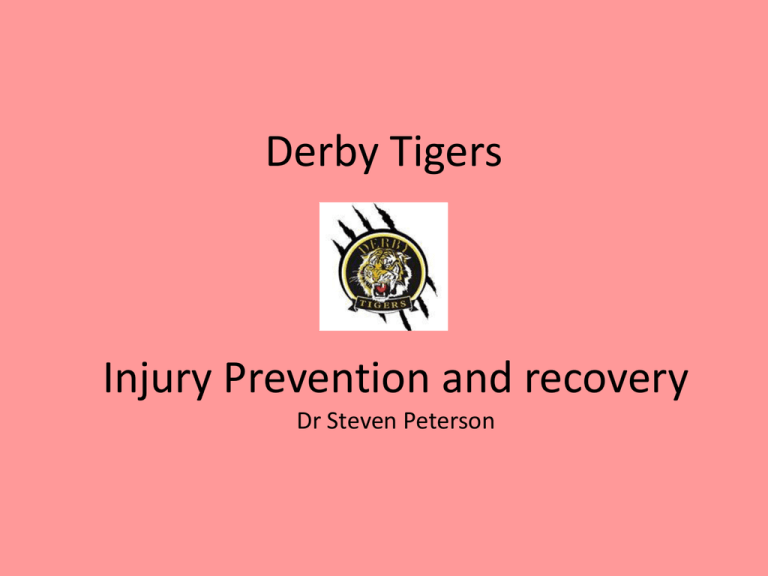
Derby Tigers Injury Prevention and recovery Dr Steven Peterson Injury Prevention • Sporting injuries are common, serious and preventable • Common – majority of AFL players can nominate an injury received or aggrevated each year – It’s a tough game • Serious – Prevent further sport or decrease performance – Lifelong disability Preventable / treatable • Prevent injuries from (re)occurring – Warm up / stretches – Strapping and protective gear – Warm down / recovery • Minimize the initial damage of injuries – Acute post injury care • Rehabilitate injuries that require it Prevention • Repair is not always possible so prevention key • Greatest risk of an injury is prior injury – Not always same injury either • Prevention for AFL – Warm up – Stretching – Taping and bracing – Protective equipment Warm Up • Prepares body for exercise – Increase blood flow to muscles – Helps mental preparation – Increase oxygen to muscles • Makes the fuel in the muscles work much, much better – Makes muscles work smoothly • More effective and less risk of tear / overstretch • Only works in last 30min before game – So not too early Warm Up – Pre AFL • Personal – whatever helps you prepare • General activity – Jogging and general stretching • Specific to your role – Practicing the movements and activities you will do on the field – 50%-75% intensity max (sweat but not fatigued) – Reduce risk of injury from specific stretched movements by 50% Stretching • To ensure smooth joint motion throughout full range of movement • Especially useful for AFL (high intensity) • Safest after the warmup • Stretching is like weightlifting – Repeated regular stretching increases the muscles strength, power and endurance – Decrease injury by 32% – Get in the habit Stretching pre game • Controversial how much it reduces injury • Probably does to targeted high risk areas – Risky if you overstretch • Static stretch – slowly assume position – Hold muscle 30 seconds at least • This causes muscle fibers to relax – After 30seconds push a little bit more – At no time discomfort • That means overstretching and possible injury Strapping • Point is to stop unwanted (over)movement – To protect from injury – To help an old one to fix • Should be done prior to warm up • Best evidence is for prevention Strapping • • • • Need rigid non-stretch tape Ankle, wrist, shoulder most appropriate Shave 8 hours prior (less skin irritation) Injured ligaments should be in shortened position prior to taping • Anchors (tape sticks better to tape than skin) • Overlap between strips • Redo if no longer firm, torn etc Equipment • Braces (knees etc) are good as can be fitted by patients but needs to be fitted correctly • Ideal football boot – Rigid heel counter – Flexible forefoot – Wide sole – Slightly curved – Adequate foot depth • Headgear not a lot of evidence Recovery • Goal is to recover from game quickly to maximize performance at training / next game – Remove lactic acid (waste product from muscle metabolism (activity)) from muscles – Start damage minimization or healing of injuries – Change from breaking down muscle to building it – Replace carbohydrate stores Recovery • Stretching helps lactic acid clearance • Gentle walking and muscle use (5-10min) • Ice bath (1-3 min) body cooling and stop swelling • Soft tissue massage • Benefit from light activity the next day • Recovery meal of carbs and protein If that doesn’t work • Injuries are individual and if concerned or unfamiliar should speak to doctor or physio • Head and neck injuries need review • General principles and advice Acute management of injury RICE • First 24 hours most important – Damaged tissue and vessels cause blood pooling, compression, hypoxia and further damage • • • • Rest - decrease bleeding and swelling Ice - 20min every 2 hours for 6 hours Compression - firm bandage over area Elevation - reduce swelling Avoid HARM • • • • Heat – causes further bleeding Alcohol – mask injury, interfere with recovery Running or other activity – further damage Massage – further swelling (I)Mobilisation • Should discuss with doctor or physio as to specific injury management • In general – short period of immobilization – Scar tissue strengthening, avoid re-injury • Mobilization avoids stiffness and weakness – May need protection to stop unwanted movement – May have passive or limited movement Drugs • Analgesia to control pain – This can help movement for rehabilitation • Anti-inflammatories for inflammation – Stop the injury getting worse • Steroid injections – bridge to buy time • Heat/cold, acupuncture, manipulation, surgery, others – speak to doc. Rehabiliation • Something to consider during off season • Work out a plan with doctor or physio • An active process after acute phase of injury – Getting strength and flexibility in injured part – Acquiring skills of sport – Returning to prior activity DAHS • Walk in bulk billing clinic • Ask to see me (or male doctor) and I will try see you quickly • Occasionally I am not there • If you want an appointment let me (0439895573) or Matt know – we will work something out
